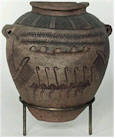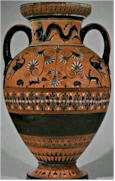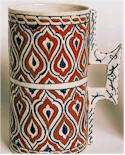
Egypt

Pottery was one of the earliest art forms
undertaken by the ancient Egyptians. This piece from the Predynastic period
(5000 bc-3000 bc) is decorated with ostriches, boats, and geometrical designs.
In the 5th millennium bc Egyptian potters made graceful, thin, dark, highly
polished ware with subtle cord decoration. The painted ware of the 4th
millennium, with geometric and animal figures on red, brown, and buff bodies,
was not of the same high standard. Dynastic Egypt was famous for its faience (to
be distinguished from the later European ceramics of that name). First made
about 2000 bc, it is characterized by a dark green or blue glaze over a body
high in powdered quartz, somewhat closer to glass than to true ceramics.
Egyptian artisans made faience beads and jewelry, elegant cups, scarabs, and
ushabti (small servant figures buried with the dead).
Greece

The Northampton Vase is an example of Greek
vase painting from the late 600s and early 500s bc. The shape of this vase is
known as an amphora, one of six standard shapes used in pottery at that time.
The mythological creatures and delicate, floral designs reflect the Greek
interest in Oriental imagery, and these forms are augmented with white and brown
highlights.
The fashioning and painting of ceramics was a major art in classical Greece.
Native clay was shaped easily on the wheel, and each distinct form had a name
and a specific function in Greek society and ceremonial: The amphora was a tall,
two-handled storage vessel for wine, corn, oil, or honey; the hydria, a
three-handled water jug; the lecythus, an oil flask with a long, narrow neck,
for funeral offerings; the cylix, a double-handled drinking cup on a foot; the
oenochoe, a wine jug with a pinched lip; the crater, a large bowl for mixing
wine and water. Undecorated black pottery was used throughout Greek and
Hellenistic times, the forms being related either to those of decorated pottery
or to those of metalwork. Both styles influenced Roman ceramics.
Even in the Bronze Age, the Greeks took advantage of oxidizing and reducing
kilns to produce a shiny black slip on a cream, brownish, or orange-buff body,
the shade depending on the type of clay. At first, decorative designs were
abstract. By the Middle Bronze Age (2000-1500 bc), however, stylized forms from
nature appeared. By the Late Bronze Age, plants, sea creatures, and fanciful
animals were painted on pots of well-conceived shape by the Mycenaeans, who were
initially influenced by Cretan potters. Athenian geometric style replaced the
Mycenaean about 1000 bc and declined by the 6th century bc. Large craters in the
Geometric style, with bands of ornament, warriors, and processional figures laid
out in horizontal registers, were found at the Dipylon cemetery of Athens; they
date from about 750 bc.
Attic potters introduced black-figure ware in the early 6th century. Painted
black forms adorned the polished red clay ground, with detail rendered by
incising through the black. White and reddish-purple were added for skin and
garments. Depictions of processions and chariots continued; animals and hybrid
beasts were also shown (particularly in the Orientalizing period, roughly 700 to
500 bc), at times surrounded by geometric or vegetal motifs. Such decoration was
always well integrated with the vessel shapes, and the iconography of Greek
mythology is clear. Beginning in the 6th century, the decoration emphasized the
human figure far more than animals. Favorite themes included people and gods at
work, battle, and banquet; musicians; weddings and other ceremonies; and women
at play or dressing. In some cases, events or heroes were labeled. Mythological
and literary scenes became more frequent. Potters' and painters' names and
styles have been identified, even when they did not sign their works.
Red-figure pottery was invented about 530 bc, becoming especially popular
between 510 and 430. The background was painted black, and the figures were left
in reserve on the red-brown clay surface; details on the figures were painted in
black, which allowed the artist greater freedom in drawing. The paint could also
be diluted for modulating the color. Secondary colors of red and white were used
less; gold sometimes was added for details of metal and jewelry. Anatomy was
rendered more realistically, and after 480, so were nuances of gesture and
expression. Although Athens and Corinth were centers for red-figure pottery, the
style also spread to the Greek islands. By the 4th century bc, however, it
declined in quality. Another Greek style featured outline drawing on a white
ground, with added colors imitating monumental painting; these vessels, however,
were impractical for domestic use.
Iran and Turkey

This mug was made in 16th-century Turkey
during the Ottoman Empire. It is earthenware, with a white underglaze and blue,
purple, and red overglazes. The floral and calligraphic designs are similar to
those found in most Islamic art. This piece is part of the collection of the
Victoria and Albert Museum, London.
The Seljuk dynasty that ruled Iran, Iraq, Asia Minor, and Syria in the 12th and
13th centuries found substitutes for porcelain, and the Iranian cities of Rayy
and Kāshān became centers for this white ware. Another fine Seljuk type was
Mina'i ware, an enamel-overglaze pottery that, in its delicacy, imitated
illuminated manuscripts. Kāshān potters, after the 13th-century Mongol
conquests, used green glazes influenced by Chinese celadons. Cobalt-blue glazes
appeared in Iran in the 9th century but later fell out of use. They were taken
up again in the 14th to the 18th century in response to the popularity of
blue-and-white ware with Chinese and European clients.
İznik was the center for Turkish pottery. There slip-painted pieces influenced
by Persian and Afghanistani ware predated the Ottoman Turks' conquest of the
region. Later, between 1490 and 1700, İznik ware displayed decorations painted
under a thin transparent glaze on a loose-textured white body; in its three
stages the designs were in cobalt blue, then turquoise and purple, then red.
During the Safavid dynasty, Kubachi ware, contemporary to İznik pottery, was
probably made in northwestern Iran, and not at the town of Kubachi where it was
found. Characteristic Kubachi pieces were large polychrome plates, painted
underneath their crackle glazes. Gombroon ware, exported from that Persian Gulf
port to Europe and the Far East in the 16th and 17th centuries, featured incised
decorations on translucent white earthenware bodies. Copper-colored Persian
lusterware was fashionable in the 17th century, as was polychrome painted ware.
In general, Islamic pottery was made in molds. Shapes were either Chinese
inspired or were the basic shapes of metalwork. In addition to lusterware, the
most creative work was the manufacture of tiles for mosques.
Pottery at a Glance|East Asian Pottery|Pre Colombian Pottery